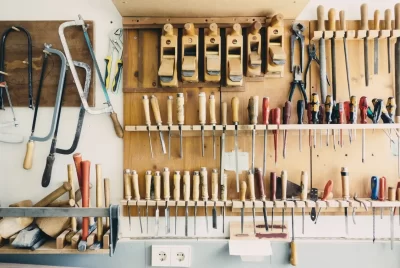Ultimate Guide to Table Saws & Best Table Saw Tools
Key Takeaways:
- Discover the essential functions and types of table saws.
- Learn about the critical parts of a table saw and their roles.
- Understand how to select the right blade for your woodworking project.
- Master advanced woodcutting techniques for more complex creations.
- Stay safe with best practices and safety technology like SawStop.
Diving into Table Saw Basics

Let’s talk table saws. They’re the workhorse of any woodshop, and with good reason. Whether you’re ripping through thick planks of walnut or making delicate cuts for a jewelry box, the table saw is your go-to tool.
The Heart of Woodworking: Understanding Table Saw Functions
Most importantly, a table saw can do more than just slice through wood. Here’s what you need to know:
- Ripping: Cutting wood lengthwise along the grain.
- Crosscutting: Slicing across the wood grain.
- Beveling: Cutting at an angle other than 90 degrees.
- Dadoes: Creating wide, flat-bottomed grooves in the wood.
Types of Table Saws: Benchtop, Jobsite, and Cabinet Models
Table saws come in different shapes and sizes, each with its own set of strengths:
- Benchtop: Compact and lightweight, perfect for small spaces and easy transport.
- Jobsite: A bit heftier, designed for durability and portability for contractors on the move.
- Cabinet: The powerhouse, built for precision and smooth operation, ideal for a dedicated workshop.
The Anatomy of Table Saws

Understanding your table saw is like getting to know a trusty friend. Here’s a quick rundown of the key parts:
Essential Parts: Table, Blade, and Fence Explained
The table is the foundation, providing a stable surface for your wood. The blade does the cutting, and it’s crucial to keep it sharp and clean. The fence is your guide, ensuring your cuts are straight and true.
A Closer Look at Miter Gauges and Throat Plates
The miter gauge adjusts for angled cuts, while the throat plate surrounds the blade, keeping the wood flat and stable during a cut.
Selecting the Right Blade
Choosing a blade can make or break your project. Here’s the scoop:
Rip Cuts Versus Crosscuts: Blade Types for Every Job
Blades come in all teeth counts and sizes, but here’s what you need to remember:
- Rip blades: Fewer, larger teeth for cutting along the grain.
- Crosscut blades: More, smaller teeth for cutting across the grain.
Combination Blades: Versatility in Woodworking
A combination blade is like the Swiss Army knife of blades, decent at both rip and crosscutting.
Advanced Woodcutting Techniques
Once you’ve got the basics down, it’s time to step up your game with some advanced techniques.
Mastering Spline Joints and Mortise Cuts
For strong, beautiful joints, splines are your secret weapon. And for sturdy furniture, mastering the mortise is a must.
Creating Taper Jigs and Round Bowl Cuts with Precision
Ever seen a round wooden bowl and wondered how it’s made? With a jig and some know-how, you can create those smooth curves on a table saw.
Navigating Table Saw Safety
No discussion about table saws is complete without a serious talk about safety. Because, let’s face it, these tools are as dangerous as they are useful.
Implementing SawStop: A Revolution in Safety Technology
SawStop technology is like having a guardian angel in your workshop. It senses skin contact and stops the blade in milliseconds, potentially saving fingers.
Guidelines for Safe Operation: From Push Sticks to Power Off
Here’s the golden rule of table saw safety: Always use a push stick for close cuts, and never forget to power off before changing blades or making adjustments.
- Always wear safety glasses and hearing protection.
- Never reach over a spinning blade.
- Keep the work area free of clutter.
Accurate Measurements and Adjustments
Accuracy is the name of the game when it comes to woodworking. A fraction of an inch off can mean the difference between a project fitting perfectly or not at all.
Crafting with Precision: Calibration and Fine-tuning Tips
Calibrating your table saw is essential for precision cuts. Start by ensuring the blade is perfectly aligned with the miter slots, and the fence is parallel to the blade.
- Check the blade alignment with a ruler or special calibration tool.
- Adjust the fence so it’s parallel to the blade to avoid kickback.
- Regularly check the accuracy of your miter gauge.
Building a Crosscut Sled for Perfect Cuts
A crosscut sled is a must-have for any serious woodworker. It gives you control and safety for crosscuts, and it’s not hard to make one yourself.
Table Saw Maintenance and Troubleshooting
Like any tool, your table saw needs love and care to keep it in top shape. Regular maintenance ensures longevity and better performance.
Regular Upkeep Routines to Extend Your Saw’s Life
Keep your saw clean from sawdust, pitch, and resin. Lubricate moving parts, and check for wear and tear on belts and gears.
- Clean the table surface with a rust inhibitor.
- Sharpen or replace blades as needed.
- Inspect safety features regularly.
Solving Common Table Saw Problems
Even the best table saws run into issues. If your cuts aren’t clean, the blade might be dull or dirty. If the saw isn’t cutting straight, check the fence and miter gauge for alignment.
Maximizing Table Saw Use in Various Environments
Whether you’re in a spacious woodshop or a cramped garage, your table saw can be the centerpiece of your woodworking arsenal.
Adapting to the Woodshop: Best Practices
In a woodshop, space is your friend. Set up outfeed tables and ample side space for handling large sheets and long boards.
Optimizing Table Saw Performance on Job Sites
On job sites, portability and quick setup are key. Jobsite saws are designed for this environment, with features like rolling stands and easy-to-adjust controls.
Continuing the Craft: Enhancing Your Woodworking Skills
Woodworking is a journey, and there’s always more to learn. As you grow, your table saw will be there, ready to take on new challenges with you.
Exploring Accessories: Track Saws and Joinery Add-ons
Besides the basic setup, there are plenty of accessories that can expand your table saw’s capabilities, like track saw attachments for straight, precise cuts, or various jigs for joinery.
Learning Through Projects: Practical Applications of Table Saw Skills
The best way to improve is to practice. Start with simple projects and work your way up. With each new project, you’ll find new ways to use your table saw and improve your skills.
Frequently Asked Questions
Got questions? You’re not alone. Here are some common queries from fellow woodworkers.
How Do I Choose the Right Table Saw for My Needs?
Consider the projects you’ll be doing, the space you have, and your budget. A jobsite saw is great for portability, while a cabinet saw is best for precision and heavy-duty use.
Can I Use a Table Saw for Complex Joinery Tasks?
Absolutely. With the right jigs and techniques, you can create dovetails, tenons, and more with your table saw.
What Safety Procedures Should I Follow When Using a Table Saw?
Always read and follow the manufacturer’s safety instructions. Use push sticks, feather boards, and blade guards to keep your fingers safe.
How Do I Maintain My Table Saw to Ensure It Lasts?
Clean it regularly, replace parts as needed, and make sure to calibrate it for accurate cuts.
Are Portable Table Saws Suitable for Professional Woodworking?
Yes, modern portable table saws are designed to be robust and accurate enough for professional use, especially on job sites where mobility is crucial.





Comments are closed.